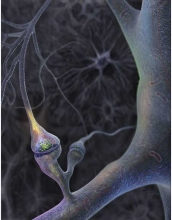|

Press Release 05-167
Science Magazine and NSF Announce 2005 Science and Engineering Visualization Challenge Winners

Winning entries appear in the Sept. 23 issue of the journal Science
September 26, 2005
Sometimes the best way to express a scientific idea is through an image that grabs the eye.
Nine entries, each telling a scientific story with a careful balance of accuracy and beauty, have won the 2005 Science and Engineering Visualization Challenge, sponsored jointly by the National Science Foundation and the journal Science, published by the nonprofit science society, AAAS.
Currently in its third year, the contest recognizes outstanding achievement in the use of visual media to promote understanding of research results and scientific phenomena. The judges' criteria for evaluating the entries included visual impact, innovation and accuracy.
The winning entries communicate information about the brilliant spectrum of fluorescing molecules, the fleeting moment when one neuron prepares to signal another, the spectacular emergence of the 17-year cicada, and more. A news story in the Sept. 23, 2005 issue of Science presents all of the entries. Winning entries may also be viewed on the magazine's web site and on the NSF web site.
The winning entries are in five categories:
ILLUSTRATION
First Place: Graham Johnson, Graham Johnson Medical Media, The Synapse Revealed
INFORMATIONAL GRAPHIC
First Place: Cheryl Aaron, Omega Optical, Inc., Fluoressence: The Essence of Fluorescence
PHOTOGRAPHY
First Place: James S. Aber, Emporia State University, Autumn Color, Estonian Bog
INTERACTIVE MEDIA
Honorable Mention: Tracy M. Sterling, New Mexico State University, Transpiration: Water Movement Through Plants
NON-INTERACTIVE MEDIA
First Place: Roger Hangarter and Samuel Orr, Indiana University, Return of the 17-Year Cicadas
Note: A web version of this movie, plus a "Science News for Kids" story about this entry, is available online at the EurekAlert! Kids Portal.
Honorable Mentions:
Mogi Massimo Vicentini, Civico Planetario Di Milano, Planetary Motion From Euxodus to Copernicus
Steve Deyo, Kevin Fuell, Katherine Olson, Dan Riter and Seth Lamos, UCAR/COMET, Rip Currents: Nearshore Fundamentals
Evan Ricks and Tim Sassoon, National Geographic TV & Film, Forces of Nature
Nina Amenta, University of California, Davis, Evolutionary Morphing: Statistical Interpolation of Ancestral Morphology
-NSF-
The American Association for the Advancement of Science (AAAS) is the world's largest general scientific society, and publisher of the journal, Science. AAAS was founded in 1848, and serves some 262 affiliated societies and academies of science, serving 10 million individuals. Science has the largest paid circulation of any peer-reviewed general science journal in the world, with an estimated total readership of one million. The non-profit AAAS is open to all and fulfills its mission to "advance science and serve society" through initiatives in science policy; international programs; science education; and more.

Program Contacts
Susan Mason, NSF (703) 292-7748 smason@nsf.gov

The National Science Foundation (NSF) is an independent federal agency that supports fundamental research and education across all fields of science and engineering. In fiscal year (FY) 2009, its budget is $9.5 billion, which includes $3.0 billion provided through the American Recovery and Reinvestment Act. NSF funds reach all 50 states through grants to over 1,900 universities and institutions. Each year, NSF receives about 44,400 competitive requests for funding, and makes over 11,500 new funding awards. NSF also awards over $400 million in professional and service contracts yearly.
 Get News Updates by Email Get News Updates by Email
Useful NSF Web Sites:
NSF Home Page: http://www.nsf.gov
NSF News: http://www.nsf.gov/news/
For the News Media: http://www.nsf.gov/news/newsroom.jsp
Science and Engineering Statistics: http://www.nsf.gov/statistics/
Awards Searches: http://www.nsf.gov/awardsearch/
| 

